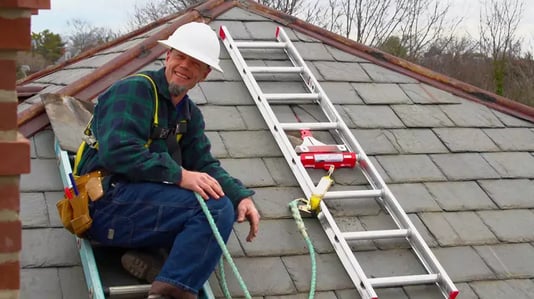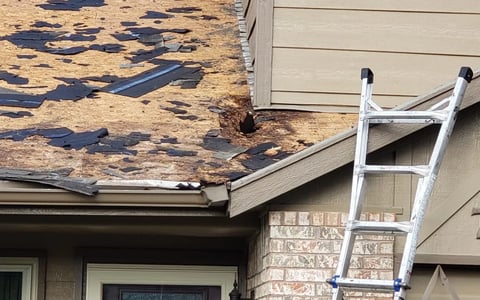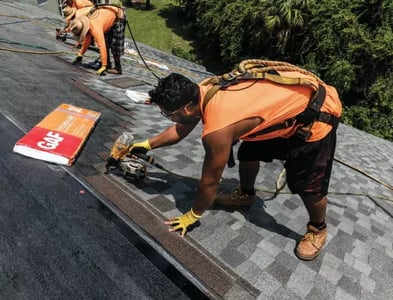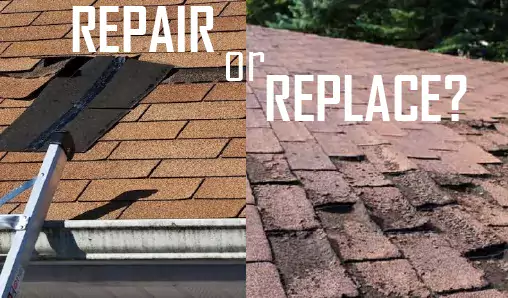What is the Most Affordable Type of Roof?
When it comes time for a roof replacement, the number one thing most homeowners are concerned about is price. The shingles you choose for your new...
You may be surprised to hear that, as a roofing contractor, we often get asked: “Are you really even necessary?”
While it sounds hurtful, we’ve learned to understand that what people really mean is: “Is this roof replacement something that I can do by myself?”
Do-it-Yourself (DIY) projects have become popular again in the internet age, as you can find detailed how-to guides for pretty much everything under the sun. The same goes for roofing.
That being said, just because something is possible, doesn’t mean that it is what you should do.
In this blog, we talk about if you can replace your own roof, some safety concerns, the tools that you would need, the steps of a DIY roof replacement, and how much it will all cost you.
Let’s get started!
As a roofing company, our obvious recommendation is going to be to always talk with a local, experienced professional before undergoing any kind of work on your roof, whether you’re doing it yourself or having someone else do it. This is why we offer free inspections and estimates to homeowners in the Raleigh, NC area.
Even though it’s to our benefit if every person decided to use us for their roof replacement, we’re more interested in earning your trust than your dollar, so we’re going to be 100% honest with you about this.
You theoretically CAN replace your home's roof, if you have the proper knowledge and experience, but the time and tools it would take, as well as the risk involved, are likely not going to be worth the money you would save by hiring a roofing company.
When it comes to a whole home, most roofs are not simple enough for one person to replace with any kind of speed or quality. Often our roofing crews can complete a roof replacement in one or two days, but that’s a full crew, that is very organized, and has been working on roofs together for a long time. Even if someone who knows a lot about roofing attempted a roof replacement by themselves, it would take a LOT longer, which increases the amount of time that your roof and attic is exposed to the elements.
That brings us to the safety aspect of it all, for your own safety, and that of your roof.
Talking about your personal safety first and foremost, roofing is a fairly dangerous job without taking the right precautions.

Professional roofers are on roofs so often, they are super familiar with how to properly walk and navigate roofs, and still use safety gear when working. Some of that gear includes harnesses, hard hats, gloves, safety goggles or glasses, and other construction clothes. If you don’t have the right gear, and roofing navigation skills, you’ll run the risk of slipping and falling, and I don’t think I need to go into why that’s not great for your health.
You’ll also need to be comfortable lifting, carrying, and throwing around a lot of weight, as one bundle of shingles can weigh between 50 and 80 pounds depending on the kind of shingle, and you’ll need to lug a lot of them up to the roof to cover it. To estimate how much you’d need, check out our blog on how to measure your roof.
As for the health of your roof, you need to be fully aware of how to install the various materials that go into a roof replacement, like drip edge, roof decking, underlayment, flashing, and starter shingles in addition to the shingles themselves. There are guides on how to do this on the web, so if you can invest the time, you can definitely learn how. However, most reputable roofing companies receive lots of training directly from manufacturers, and have years of experience installing roofing materials. If these items aren’t installed correctly, it could create a chink in your roofs armor, and all it takes is one strong storm to expose it in a costly way.
You also will want to take the environmental conditions into account, as installing a roof during weather that is too hot or too cold not only takes a toll on you, but can also cause damage to your new shingles.
The tools that you’ll need for a DIY roof replacement are pretty much the same that every roof replacement needs. A hammer or air nailer, more roofing nails than you’d think, tarps to protect the house and yard, a ladder, tools to scrape off the old shingles, a dumpster for disposing of them, a saw and knife for cutting materials, a magnet to pick up fallen nails, and a wheelbarrow to move everything around.
It's a good bit of tools, but it’s really the least of what you’d need for a roof replacement, for even a small home. Again, we’re not TRYING to scare you, but we want to make sure that you know what you’re getting into when you start on this project.
Alright, with those disclaimers out of the way, let’s talk about the process of replacing your roof.
As far as what you’ll need to do during the actual project, there are six main phases. Please keep in mind this isn’t going to be a full step-by-step guide, but we will be talking about the order in which things need to happen.
Before you get started doing anything else, you’ll need to clear out anything that might get damaged by falling debris, like your car or any decorations, and cover up any bushes or sensitive areas of the house. You’ll want to get your dumpster delivered or set up at this time as well, so that it’s ready to handle the debris from the roof tear off.
For the tear off, you’ll want to be super careful to not over-exert yourself, and to be sure you don’t fall. Most roofers will start at the top of a roof, tearing off the old ridge cap shingles, and then work their way down while scraping off the shingles. After it’s all off, you’ll need to get it into the dumpster by loading it into your wheelbarrow and emptying it into the dumpster.
While your shingles are off, this is a great opportunity to inspect your roof decking for any water damage or wood rot.

If you spot any of these issues, you’ll need to replace that section of decking BEFORE you put back on any other roofing materials. It’s very important that your decking is replaced, as any section of damaged decking will weaken that entire area, leading to the increased potential for roof collapse, and roof leaks.
The next step after replacing any pieces of rotten roof decking is to install the other roofing materials, like the underlayment, drip edge, starter shingles, ice & water shield, and flashing (link). If those terms are unfamiliar to you, no worries! We've done blogs on each of those topics, which you can find by clicking on each of those words above!
Next up comes the “fun” part, installing the shingles. You may have to cut some shingles to fit, but for the most part you’ll just be nailing them together, overlapping them up the roof. Be sure to follow the instructions laid out by the manufacturer, as different shingles may require a different number, or spacing of nails.

Last but not least, the clean up! Hopefully you took some time earlier to cart around the majority of the torn off roof, because that will make your work at the end much easier. For this section, we’d recommend taking a leaf blower around your gutters and then top of your roof, getting out all of the clogs and other debris. Then, do a few laps around the area with a magnet, picking up nails, and shaking out the downspouts to make sure everything came out of the gutters.
Once you’ve done this, you can sit back and admire all the hard work you put into your new roof! You may have noticed that this process sounds like a ton of work for one person, and it really is. That’s why we do not recommend attempting to replace your own roof, unless it’s on something like a small shed, gazebo, or building that isn’t as critical to the health of your home.
If the solo-reroofing project still seems manageable to you, now its time to talk about the kind of money you might be able to save. It depends a lot on the size of your roof, but the average roof replacement that we do tends to be about $10,000 to $15,000. As for how much it would cost you to do, you’ll need to know the size of your roof, which you can then use to estimate how many bundles of shingles you will need for your job.
Typically, three bundles of shingles will cover one “square” (or, 100 square feet) of the roof. Once you’ve estimated how many squares you’ll need, you can figure out how much that will cost you by going to Home Depot and taking a look at how much they will cost for your job. Then, of course, you’ll also need to factor in other materials, like the underlayment, flashing, vents, drip edge, ice & water shield, and starter shingles.
After reading this, we hope that you’ve had some questions about your DIY roof replacement cleared up! If you have the right experience, it’s definitely possible for smaller roofing projects, but ultimately for the average home, it would likely be too difficult for one person to complete in a timely, safe manner.
If you live in the Raleigh, NC area, and want a professional to come take a look at your roof, reach out to us using the “Contact Us” button below! Fill out the form on that page and we will get you in touch with you, and help set up a time to learn some more about your specific situation. Whatever your roofing project is going to require, we’re happy to help!

When it comes time for a roof replacement, the number one thing most homeowners are concerned about is price. The shingles you choose for your new...
_WebP.webp)
When it comes time for a roof replacement, it can be overwhelming to hear unfamiliar roofing terms casually tossed around like you’re supposed to...

One of the biggest decisions homeowners have to make regarding their roof is whether or not they want to get a roof repair, or a roof replacement.